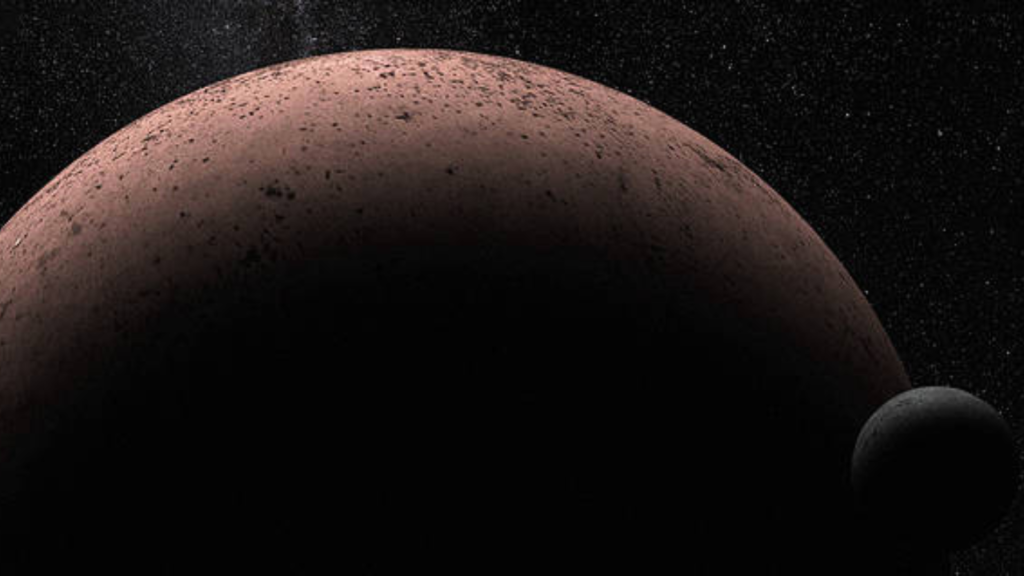The Kuiper belt is one of the most unique regions in the solar system housing hundreds of thousands of icy bodies larger than 100 km and trillions of comets. Astronomers estimate that over 200 dwarf planets exist in the Kuiper belt. One of these dwarf planets is the Makemake (pronounced as MAH-kay MAH-kay), which is the second brightest dwarf planet of the Kuiper. Makemake is one of the five dwarf planets officially recognized by the International Astronomical Union.
In April 2015, Astronomers used Hubble’s Wide Field Camera 3 to observe the Kuiper belt in search of newer discoveries for humanity. Since Hubble is sophisticated enough to observe faint objects closer to brighter ones, it enabled astronomers to discover the moon orbiting around Makemake from the dark region. Several previous observations made to discover moons around Makemake failed. However, scientists were fascinated with the fascinating outcome of their 2015 observation.
“Our preliminary estimates show that the moon’s orbit seems to be edge-on, and that means that often when you look at the system you are going to miss the moon because it gets lost in the bright glare of Makemake,” said Alex Parker of Southwest Research Institute, Boulder, Colorado, who led the image analysis for the observations.
This moon is nicknamed MK2 and it reflects sunlight with its charcoal-dark surface. Its reflection of the sun is about 1,300 times dimmer than its host dwarf planet. It was first discovered unintentionally by the Hubble Space Telescope in 2016. Astronomers intended to use the Telescope and find small satellites of Pluto. However, astronomers discovered the MK2 around the Makemake moon instead.
How Astronomers Are Working towards Unveiling more facts about the newly discovered dwarf planet’s moon

Whenever astronomers discover a celestial body, they often conduct further observations to learn more about the heavenly body. As for the next plan of the MK2, astronomers will conduct further observations to measure its density and mass to understand more about the celestial body.
Just like as astronomers studied Pluto and its Satellites, they will follow the same procedure to study Makemake and its moon as well. Based on the observations so far, scientists learned that Mk2 is about 160 kilometers (100 miles) across. However, Makemake is estimated to have 1,400 kilometers in diameter. The relative size of the dwarf planet and its moon are shown in a graphics illustration above.
“An imagined scene of an unexplored frontier of the Solar System, it looks back from a spacecraft’s vantage as the dim Sun shines along the Milky Way,” NASA official wrote describing the image. “Of course, the Sun is over 50 times farther from Makemake than it is from planet Earth.”
What Scientists Think About Makemake’s Moon
Scientists hoped to learn a lot from the discovery of Makemake’s moon including how satellites exist around dwarf planets.
“Makemake is in the class of rare Pluto-like objects, so finding a companion is important,” Parker said. “The discovery of this moon has given us an opportunity to study Makemake in far greater detail than we ever would have been able to without the companion.”
The researchers will still have to conduct more observations using the Hubble space telescope to accurately determine whether its orbit is circular or elliptical. Astronomers estimate that if the moon is in a circular orbit, then it will take about 12 days or a bit longer to complete a circuit around Makemake. Learning about the shape of the moon’s orbit will enable scientists to determine how it originated around the dwarf planet.
If astronomers discover that the moon has a tight circular orbit, it means that MK2 came into existence due to a possible collision between Makemake and another object in the Kuiper Belt. However, if the moon orbits the dwarf planet in a wide and elongated orbit, it possibly means that it may have been captured from the Kuiper Belt. Astronomers strongly believed that the moon has been orbiting the dwarf planet for several billion years, starting from the early solar system.
Previous infrared studies revealed that the dwarf planet’s surface is mostly bright and extremely cold. However, some region still appears warmer than other areas. But the previous infrared data did not have enough resolution that separates Makemake from MK2. The Hubble Observation team analyzed the data again and concluded that the warmer surface of Makemake that was previously detected may be an infrared light which may have been the dark surface of the companion MK2.
“There are several possibilities that could explain why the moon would have a charcoal-black surface, even though it is orbiting a dwarf planet that is as bright as fresh snow,” NASA published in a statement, “One idea is that, unlike larger objects such as Makemake, MK 2 is small enough that it cannot gravitationally hold onto a bright, icy crust, which sublimates, changing from solid to gas, under sunlight. This would make the moon similar to comets and other Kuiper Belt Objects, many of which are covered with very dark material.”
Conclusion
The Kuiper belt is one of the most fascinating regions in the Solar System. the discovery made by the Hubble observation team has just increased our desire to visit and explore the Kuiper belt region. What do you think about the newly discovered moon orbiting a dwarf planet?





Awesome brain food Tanksalot!!!